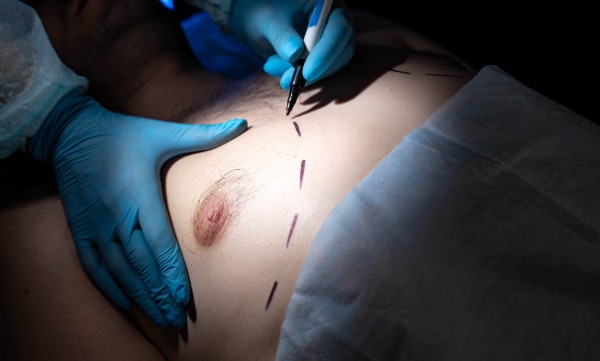
Gynecomastia is when the male breast is larger than usual, usually caused by an estrogen and testosterone hormone imbalance.
In puberty, some infants, boys, and older men may develop enlarged breasts as their hormone levels change. It’s not a severe condition, but it can make boys and men feel self-conscious.
Gynecomastia in Houston often goes away by itself, but if it doesn’t, you may want to consider male breast reduction surgery.
Some symptoms of the condition include:
- Pain, most often in adolescents
- Swollen breasts
- Tenderness in the breasts
- Nipples are sensitive when rubbing against clothes
Some of the hormone imbalance conditions that can cause gynecomastia are:
- Aging: Hormone levels can change in men as they age, especially those who are overweight.
- Hyperthyroidism: The thyroid gland makes too much thyroxine, which can increase the size of the breasts.
- Liver failure: Hormone levels can change when the patient has liver problems.
- Malnutrition: If the body is deprived of food, there is a drop in testosterone levels, and estrogen levels stay the same.
Below is more information about gynecomastia surgery so you can decide if you want to consider a gynecomastia surgery procedure.
Gynecomastia Surgery Overview
The goal of a male breast reduction procedure is to restore the male breast to its normal size and contour. Your surgeon may use liposuction, excision, or a combination of these procedures during your gynecomastia surgery. If you have excess breast tissue, liposuction is ineffective, so it needs to be excised.
Surgeons most often use the intra-areolar incision, which goes along the bottom part of the areola; the length of the incision depends on your anatomy.
One of the most popular gynecomastia surgery procedures today is the ‘pull through’ method. First, your surgeon makes a tiny incision at the edge of the areola. Then, after liposuction, the glandular tissue is pulled through the small incision.
This gynecomastia surgery is desirable because of the small incision that is almost invisible when it heals.
Another popular method to reduce the size of the male breasts is ultrasonic liposuction. This form of liposuction uses ultrasonic waves to break up the fat cells for easier removal.
However, ultrasonic liposuction isn’t effective if you have glandular gynecomastia; this condition requires excision surgery for best results.
Can Gynecomastia Return?

A study in the Aesthetic Plastic Surgery Journal in 2017 found that about 12% of men who had gynecomastia surgery had recurrence within a decade.
The most common reason that gynecomastia returns is the surgeon didn’t remove all of the glandular tissue. This may be because the surgery was done by an inexperienced surgeon.
Another reason may be that the patient was treated for another condition called pseudogynecomastia. This means you have excess fatty tissue over the breast but not excess breast tissue.
Gynecomastia is usually treated by removing the extra glandular tissue, while pseudogynecomastia is treated by removing the excess fat cells with liposuction.
Clinical studies also suggest other various factors can cause gynecomastia, such as using several drugs and medications.
Steroids, alcohol, and opioids are known to cause gynecomastia. If you continue to use these substances after surgery, you could have a recurrence.
Gynecomastia Recovery
Keep in mind that you will have some swelling and scarring during your gynecomastia recovery that can make you think you’re having a gynecomastia recurrence.
Swelling is substantial after this surgery, but it should recede after three or four weeks. However, some patients also report their chest starts to fill out after four or five weeks. This is often caused by scar tissue, but it won’t affect how your chest looks in the long term.
If you feel hard scar tissue in your chest after surgery, massaging it gently with your fingers can help.
However, if the hardness is only under the nipple and there’s swelling, you may have fluid buildup, also called a seroma. If you think this is happening, have it checked by your surgeon.
Fortunately, seromas can be drained with a needle at the doctor’s office.
Statistics indicate that up to 70% of men will have gynecomastia to some degree during their lives. This condition can be embarrassing, and many men may become depressed or anxious and suffer lowered self-esteem. Gynecomastia surgery can help.
Most patients who have male breast reduction surgery are pleased with the results. So, talk to your plastic surgeon about gynecomastia surgery today.
Questions and Answers
Can gynecomastia come back after surgery?
Can gyno come back after surgery? This is a common concern. Certainly, gynecomastia can recur after male breast reduction surgery, although it’s exceedingly rare. Consensus among experienced plastic surgeons and supported by research affirms this uncommon occurrence.
What does it look like if I still have gynecomastia after surgery?
Residual edema, surgical scarring, lingering breast tissue, or excess skin could contribute to your condition, often resolving within a period of up to six months.
Can gynecomastia surgery go wrong?
Injuries to deeper structures, like nerves, blood vessels, muscles, and lungs, may be temporary or permanent. Possible complications include deep vein thrombosis, cardiac and pulmonary issues, fat necrosis in breast tissue, and fluid accumulation (seroma).
Request a Houston Gynecomastia Consultation
Interested in gynecomastia surgery in Houston? Please set up a consultation with Dr. Ashley Steinberg today. She’ll talk to you about the benefits and risks of gynecomastia and determine if you’re a good candidate.
References
The Satisfaction Rate Among Patients And Surgeons After Perareolar Surgical Approach To Gynecomastia Along With Liposuction. (2016). Accessed at https://www.ncbi.nlm.nih.gov/pmc/articles/PMC5109391/
Gynecomastia Causes. (n.d.). Accessed at https://www.mayoclinic.org/diseases-conditions/gynecomastia/symptoms-causes/syc-20351793
Enlarged Male Breast Tissue – Gynecomastia. (n.d.). Accessed at https://my.clevelandclinic.org/health/diseases/16227-enlarged-male-breast-tissue-gynecomastia
Gynecomastia Overview. (n.d.) Accessed at https://www.smartbeautyguide.com/procedures/for-men/gynecomastia/












